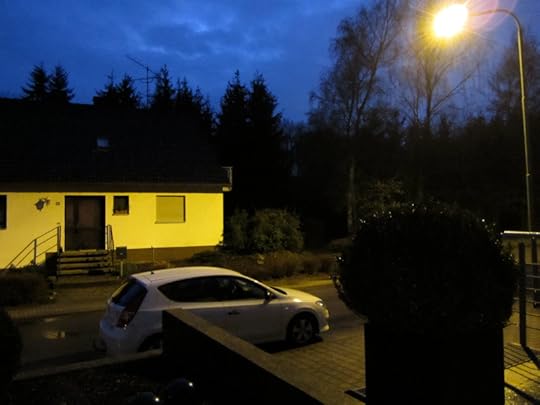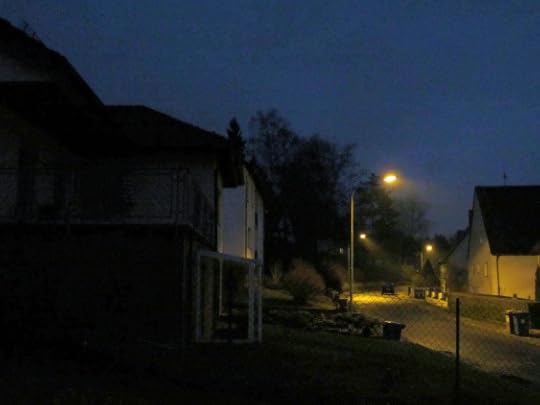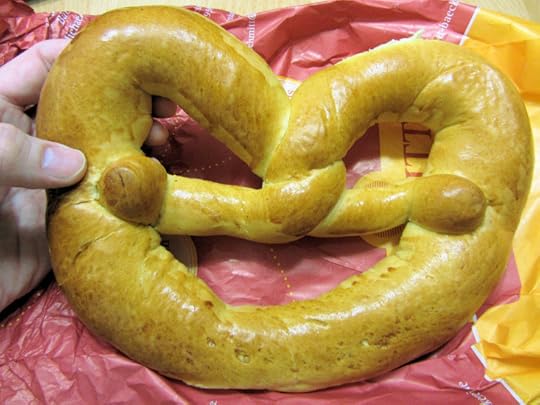Clare B. Dunkle's Blog, page 8
January 19, 2012
How Many People Live There?
Germany is not like the Texas suburbs I grew up in, with their obsessive-compulsive zoning laws separating business, homeowner, and apartment dweller. Many houses in Germany contain built-in apartments, and many regular homeowners are also landlords. Given their population/landmass ratio, Germans have only a ninth as much area per person as we have. Also, the majority of Germans rent instead of buy, so apartments are a fact of life. ("Buying") And family ties are strong. A built-in apartment is a prudent way to provide for a child or an aging parent.
The very large house in the photo above certainly contains multiple families. We can see three separate entrances, for a start. But a house needn't have a separate entrance to hold more than one household.
This charming house has only one front door. But that door opens onto a locked entrance hall and a stairwell. The homeowners live on the ground floor and basement floor–technically another ground floor since the house is built into a hill. Their tenant lives in an apartment under the roof.
Once you know to look for them, you'll find evidence everywhere of apartments built into "regular" houses. You may notice a separate street entrance for a basement level.
And if it's registered as a separate residence, it will have its own mailbox.
What does this mean for Americans who are moving to Germany?
It means that you will very likely end up with three floors. After living on three stories for seven years, I swore I wouldn't do it again, but Joe and I have fallen in love with a two-story house that contains a full basement apartment. Many duplexes are three-story units as well.
It means that you may have two full kitchens. That second oven can be very handy when the holidays roll around.
It also means that your landlords may live just upstairs or downstairs from you. In my experience, that's one of the nicest things that can happen.
Now go back to look at the cute little yellow house from last week's post. Do you see the apartment (and its mailbox)?
HowToGermany.com. "Buying a House or Apartment in Germany." n.d. Retrieved from http://www.howtogermany.com/pages/hou...
To read my latest blog posts, please click on the "Green and Pleasant Land" logo at the top of this page. Photos taken in January, 2012, in Rodenbach and Weilerbach, Germany. Text, photos, and video copyright Clare B. Dunkle and Joseph R. Dunkle.
January 18, 2012
die Erdkugel
The other night, I was watching a television show on World War II. The number of World War II shows on television here is truly astounding! One of the subject matter experts was discussing naval warfare. After talking about U-boats in the Atlantic, he said, "Meanwhile, on the other side of the Erdkugel…"
Erdkugel? How charming! Die Erde is land, soil, or earth. Die Kugel is a bullet, ball, or sphere. So die Erdkugel is a ball of earth–in other words, the terrestrial globe.
January 12, 2012
At Home
Consider this German home: thoroughly modern and downright adorable. This is what realtors mean by curb appeal.
This German house probably dates from the 1800s. Still, it has a lot in common with the modern house above it, and several of these design features differ dramatically from most American houses.
First, both houses have rollladens (also spelled "rolladen"), rolling shutters that come down over the outside of a window or door. A rolladen can be lowered from inside the house by means of a button or a strap by the window. Fully closed, it blocks the light completely. The rolladens are halfway down on the lower house. On the upper house, we can see the silver holders above the windows that store the rolled-up rolladen, and the rolladen at the balcony is down. The irregularly shaped windows have no rolladen.
Who needs rolladens anyway? Everybody! Rolladens are wonderful. By keeping sunlight off window glass, they help keep a house cool in summer. And with summertime twilight starting at 4:30 AM and ending at 11:30 PM, they're the only thing that can guarantee restful sleep.
But while we're on the subject of windows, here's a less pleasant observation: all that pretty, shiny window glass means that neither house has screens. What keeps the flies out? Nothing!
Both houses are of stone, with tile roofs. Germans around here don't frame in wood like we do, which they consider a flimsy building style. They build in concrete block "für die Ewigkeit" — for forever. Both houses also have a strong central roof beam, and the upper stories have sloping ceilings.
I can virtually guarantee another similarity: no doorknob on the front door.
German front doors can be surprisingly beautiful. But they open with a key, not the turn of a knob. If you walk outside, you'd better have that key! A quick trip to take out the garbage might leave you trapped outdoors.
Our two houses may also have a sun room (Wintergarten), a highly desirable and common house feature. Here is a retrofitted Wintergarten on an older house.
And here is a modern Wintergarten.
Next Tuesday: How many people live in that house?
To read my latest blog posts, please click on the "Green and Pleasant Land" logo at the top of this page. Photos taken in January, 2012, in Rodenbach and Weilerbach, Germany. Text copyright Clare B. Dunkle. Photos copyright Joseph R. Dunkle.
January 11, 2012
die Gebärdensprache
The other night, as I was flipping channels, my television informed me that the title of the next show was Die Gebärdensprache. What kind of Sprache (speech)? I found out that sich gebärden means to behave or act, and die Gebärde is a gesture. So die Gebärdensprache is sign language.
January 10, 2012
Happy New Year!
What a peaceful nighttime scene! Just a quiet street in Rodenbach, Germany. But that was before the madness.
I'm from the western United States, a land of droughts, dead vegetation, and fast-moving wildfires. More than 21,000 wildfires burned across my state last year, causing homeowners over a hundred million dollars' worth of damage. (Smith) Fireworks are forbidden where I live. Usually, the city puts on a nice fireworks display for the Fourth of July, but last year, even that had to go. (Gonzalez)
Germans don't share this particular worry. Their houses are usually stone, brick, or concrete block, their roofs are tile, and this year in particular, their land is thoroughly soggy, with almost eight inches (200 mm) of rain falling in December alone. Fireworks turn up in lots of stores here before New Year's Day, and I'm not just talking about sparklers and caps, I'm talking about entire display sets with timers and electronic fuses.
The result is astounding!
Click on the image above to link to a short Youtube video Joe took of the fireworks on our street. Every single street around here turns into a stunning fireworks battleground after midnight. Rockets explode in glittering chrysanthemum starbursts. The noise is enough to create a kind of auditory claustrophobia. Smoke forms a low-lying cloud and hangs in the air. And the fun lasts for a good forty-five minutes.
I love New Year's in Germany!
Next morning, Rainer paid us a visit to bring us a New Year's Day pretzel. This monster pretzel, which Joe is grasping in the photo above, is made of sweet bread and brings good luck. That tickled my fancy. I knew my Scottish ancestors would have been even happier to see Rainer than to see his pretzel. According to the "first-foot" tradition in Scotland, good or bad luck comes from the first person across the threshold in the new year, and a dark-haired male brings the best kind of "first-foot" luck.
By sheer happenstance, Joe and I also wound up eating black-eyed peas on New Year's Day, so our good fortune this year should be unassailable.
Smith, Aaron. "Wildfires and drought cost Texas billions." CNN Money, September 8, 2011. Retrieved from http://money.cnn.com/2011/09/08/news/...
Gonzalez, John W. "Fireworks shows snuffed for July 4." My SA, June 24, 2011. Retrieved from http://www.mysanantonio.com/news/loca...
To read my latest blog posts, please click on the "Green and Pleasant Land" logo at the top of this page. Photos taken in January, 2011, in Rodenbach, Germany. Text, photos, and video copyright Clare B. Dunkle and Joseph R. Dunkle.
January 9, 2012
das Vorbild
One of the interesting things about life in Germany is listening to a German-language sermon each Sunday. Last Sunday was devoted to the Holy Family–Jesus, Mary, and Joseph–and Father spoke at length about what a wonderful Vorbild that family is for us. Das Bild is a picture, photo, or likeness, and vor means before or in front of. So das Vorbild is the picture set in front of you. Das Vorbild is an example.
December 31, 2011
The New St. Vith
I've always loved the high rounded hills and wide valleys near Spangdahlem Air Base. They're colorful even in the middle of winter. This is the Eifel, a land of strong winds, big sky, and beautiful scenery. Thousands of years ago, the Eifel was the site of volcanic eruptions. Now round lakes nestle peacefully in the cones where lava once bubbled out.
Here, gigantic windmills dwarf a forest of mature pine trees. Wind is an important component of Germany's renewable-energy plan. Renewable-energy sources already account for a solid twenty percent of Germany's total energy consumption. Wind contributes seven and a half percent. ("Crossing")
If this evangelist looks a bit grim, he's probably thinking about the history of his town: St. Vith, on the border between Germany and Belgium. This chic and friendly little town, just up the highway from Spangdahlem Air Base, changed nationalities three times in a hundred and twenty-five years, swapped among Luxembourg, Germany, and Belgium like a lucky penny. The Germans took it over in World War II. Then the Americans moved through. But we lost St. Vith during the Battle of the Bulge, and by the time we took it again thirty days later, there wasn't an "it" to take. The entire town had been destroyed. The only building that remained undamaged was an old medieval tower. Everything else was gone.
So tourists are cordially invited to visit the new St. Vith, and it's a very nice place to spend an afternoon. We can only hope that the pleasant little downtown, which particularly invites window shopping, will never again echo with gunfire and explosions. Maybe time and peace and rain will erase the creases in the evangelist's forehead, and after a few hundred years, he'll relax and begin to smile a little through his beard.
What does Belgium have that Germany doesn't have? Belgium has Belgian beer! According to Ratebeer.com, Belgium produces thirteen of the hundred best beers in the world, and twelve of the top hundred beers at BeerAdvocate.com. When you consider that little Belgium is only the size of Maryland, that's pretty remarkable.
"Crossing the 20 Percent Mark: Green Energy Use Jumps in Germany," Spiegel Online International. 08/30/2011. Retrieved from http://www.spiegel.de/international/0...
Ratebeer.com. (n.d.) Best Brewers In The World 2011. Retrieved from http://www.ratebeer.com/RateBeerBest/...
Beeradvocate.com. (n.d.) Top Beers–Popular. Retrieved from http://beeradvocate.com/lists/popular
To read my latest blog posts, please click on the "Green and Pleasant Land" logo at the top of this page. Photos taken in December, 2011, in the Eifel, Germany, and St. Vith, Belgium. Text and photos copyright Clare B. Dunkle.
die Tarnung
In my Lucky Luke comic book, the cowboy warns that he and his friend are entering the territory of a tribe that has mastered die Tarnung. What have they mastered? You can tell from the photo above. Die Tarnung means camouflage.
Image copyright Lucky Luke Comics, 2001. German translation copyright EGMONT EHAPA VERLAG GmbH, 2001.
December 28, 2011
Not your Grandma's Religion
One of my blog readers recently had a "culture shock" moment. He's a nurse, and he was filling out a patient questionnaire with a German woman. When he asked her religion, she became upset. What went wrong?
Religion and society interweave in very different ways in America and Germany. For instance, in America, we don't put Christian art on our government buildings or in our streets. But Germany has been Christian for centuries, and all the photos today are examples of public Christian art. St. George, in the one above, is on Saarbrücken's city hall! And most German holidays are Christian in origin.
Although the German constitution guarantees religious freedom, it doesn't guarantee the separation of church and state. German tax forms ask for religion and levy a surcharge on those who declare one that goes to the church of their choice. Germans who don't pay this have no right to an official church marriage or funeral.
Nevertheless, many Germans today aren't what we would consider religious. They don't attend services. They view religion as something important to the elderly, particularly since clergy are called to the dying. And they view us Americans with some concern because we often go to church weekly and get involved in issues like whether "under God" should be in our Pledge. That seems to Germans to border on fanaticism.
We Americans, who view religion as a personal choice and a matter of personal identity, are usually proud to proclaim our religion. If we don't have a religion, we're usually proud to proclaim that too. We know the government won't get involved. But that's not true in Germany.
So, back to the German patient. What did she hear when asked, "What is your religion?"
1. "The government is getting into your business."
2. "You look like a granny to me."
3. "You look like you're dying."
4. "This may be a factor in arranging your funeral."
No wonder she got upset!
Here's an approach that might have worked better:
"This hospital has chaplains who are happy to visit patients. Would you like a chaplain to visit you? If so, which religion?"
To read my latest blog posts, please click on the "Green and Pleasant Land" logo at the top of this page. Photos taken between September and November in various cities in Germany. Text and photos copyright Clare B. Dunkle.
der Vorteil
Teilen means to part, to divide into parts, or to share out in parts, so der Teil (also das Teil) is a part or a fraction. But which part is der Vorteil? That's the part that sets itself vor — ahead of all the others. Der Vorteil is an advantage, a benefit, or a strategic edge.
Clare B. Dunkle's Blog
- Clare B. Dunkle's profile
- 390 followers
























